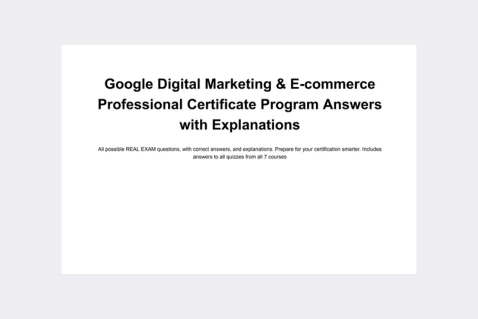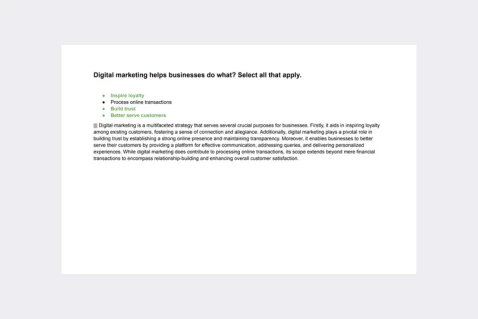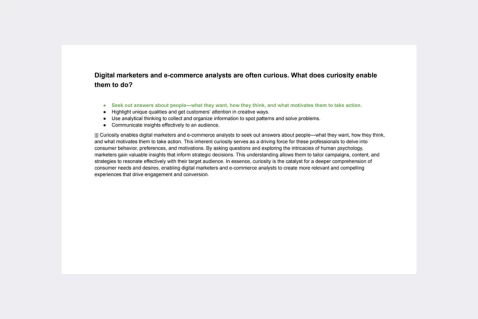A marketer only pays when someone takes action on their ad. What type of advertising model is this?
Revenue sharing
Conversion rate advertising
Pay-per-click (PPC)
Cost-per-impression (CPM)
Certification program: 👉 Google Digital Marketing & E-commerce Professional Certificate (Coursera)
Explanation: The advertising model where a marketer only pays when someone takes action on their ad is known as “Pay-per-click (PPC).” In this model, advertisers are charged only when a user clicks on their ad, directing them to the advertiser’s website or landing page. It’s a performance-based pricing strategy, ensuring that advertisers pay for actual engagement rather than just ad exposure. PPC is widely used in online advertising platforms, allowing advertisers to set budgets and bid on keywords relevant to their target audience. This model is effective for measuring the direct impact and effectiveness of an advertising campaign, as advertisers are billed based on the specific actions (clicks) that users take in response to their ads.
Passing exams is not a workout. Multiple attempts won’t make you stronger.



- All possible certificate program questions
- Real certification exam questions
- Detailed answer explanations.
- Over 1700 questions, 7 courses, 30 quizzes
- Free lifetime updates.
Exploring Performance-Based Advertising: A Cost-Efficient Approach to Marketing
In the dynamic landscape of digital advertising, marketers are continually seeking ways to maximize their return on investment (ROI) and drive tangible results for their campaigns. One increasingly popular advertising model that aligns with this objective is performance-based advertising. But what exactly is performance-based advertising, and how does it offer a cost-efficient approach to marketing? Let’s delve into this topic and uncover some practical insights.
Understanding Performance-Based Advertising
Performance-based advertising, also known as pay-for-performance advertising, is an advertising model where advertisers only pay when a specific action is taken on their ad. This action could be a click, a lead form submission, a sale, or any other predefined conversion goal. Unlike traditional advertising models where advertisers pay based on impressions or ad placement, performance-based advertising shifts the focus to measurable results and ROI.
Advantages of Performance-Based Advertising
Performance-based advertising offers several advantages for marketers:
1. Cost Efficiency
By only paying for actual results, performance-based advertising offers a cost-efficient approach to marketing. Advertisers can allocate their budget more effectively, focusing on channels and tactics that deliver the highest return on investment. This helps minimize wasteful spending on ineffective campaigns and ensures that resources are utilized optimally to drive tangible outcomes.
2. Measurable Results
Performance-based advertising provides clear and measurable results, allowing marketers to track the effectiveness of their campaigns with precision. Through advanced analytics and tracking tools, advertisers can monitor key performance indicators such as click-through rates, conversion rates, cost per acquisition, and return on ad spend in real-time. This data-driven approach enables marketers to make informed decisions, optimize their campaigns, and maximize ROI.
3. Risk Mitigation
Since advertisers only pay when a desired action is taken, performance-based advertising reduces the risk associated with traditional advertising models. Marketers can experiment with different ad creatives, targeting strategies, and messaging without incurring upfront costs. This flexibility encourages innovation and allows advertisers to adapt their strategies based on real-time feedback and performance metrics.
Practical Insights for Performance-Based Advertising
-
Define Clear Conversion Goals: Clearly define the desired action you want users to take, whether it’s a click, a lead submission, or a purchase, to align with your business objectives.
-
Optimize Landing Pages: Ensure that your landing pages are optimized for conversions to maximize the effectiveness of your performance-based advertising campaigns.
-
Implement Conversion Tracking: Utilize conversion tracking tools provided by advertising platforms to accurately measure and attribute conversions to your ads.
-
Continuously Monitor and Optimize: Regularly monitor the performance of your campaigns and make data-driven optimizations to improve results over time.
In conclusion, performance-based advertising offers a cost-efficient and results-driven approach to marketing, allowing advertisers to pay only for measurable outcomes. By focusing on driving tangible results, maximizing ROI, and mitigating risk, performance-based advertising empowers marketers to achieve their business objectives effectively in today’s competitive digital landscape.
Now, armed with a deeper understanding of performance-based advertising, how will you leverage this model to drive results and achieve your marketing goals?
Discover our best-value guides
- Special Bundle Offer Google_Ads_Roll
- Special Bundle Offer HubSpot_Exams_Roll
- Special Offer Unchained_Guru_Roll
- Special Bundle Offer Amazon_Roll
- Special Bundle Offer Google_Analytics_Roll
- Special Bundle Offer Google_SkillShop_Roll
- Special Bundle Offer Marketing_Platforms_Roll
- Special Bundle Offer Microsoft_Advertising_Roll
- Special Bundle Offer YouTube_Roll
- Special Bundle Offer Google_Android_Roll
- Ultimate PMP certification preperation guide
- Google Cloud Professional Architect Certification Exam Answers - Ultimate Guide
- Special Bundle Offer SEMrush_Roll